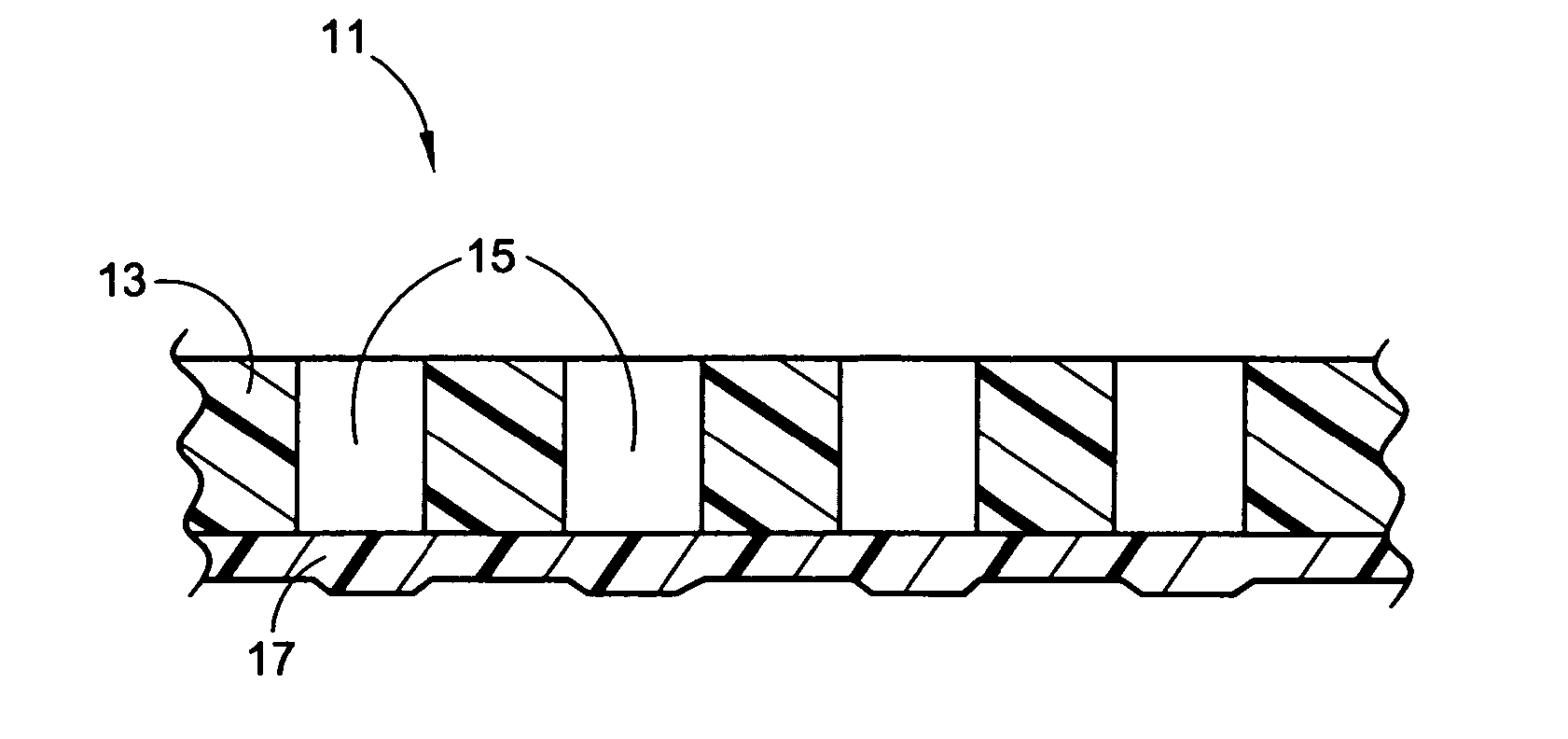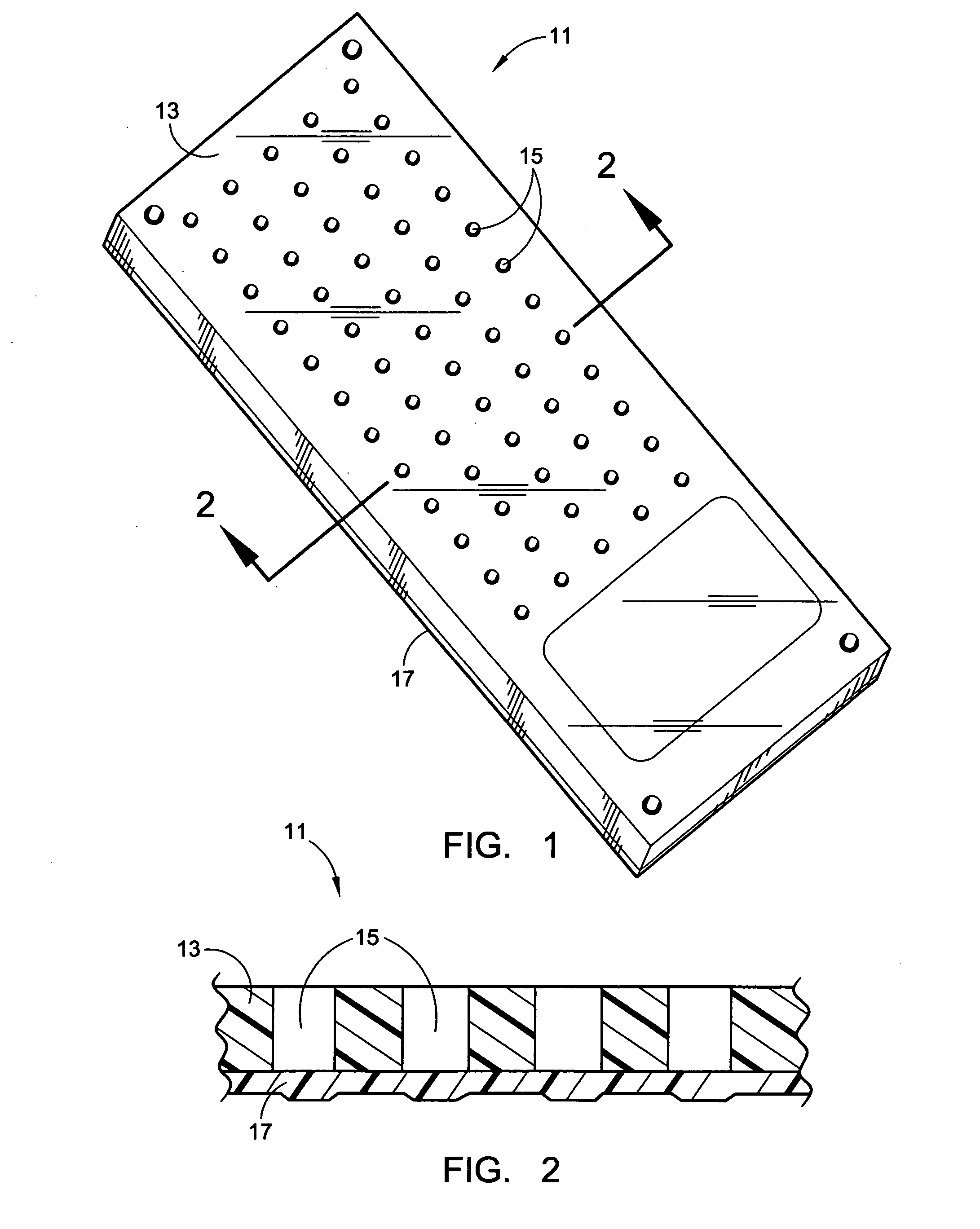Microwell biochip
a microwell and biochip technology, applied in the field of microwell biochips, can solve the problems of difficulty in optically obtaining accurate quantitative assays, fluid handling, and additional cost of producing such high density microtiter plates
- Summary
- Abstract
- Description
- Claims
- Application Information
AI Technical Summary
Problems solved by technology
Method used
Image
Examples
example 2
Printing and Hybridizing with a Microwell Protein Biochip
[0029] Protein Formulations for Printing
[0030] A mixture of Anti-transferrin antibody in Hypol (Hampshire Chemical Corporation, Lexington, Mass.) and nonspecific IgG in Hypol (as blank control) were printed and then tested with Cy3-labeled transferrin. HYPOL is an isocyanate-capped PEG prepolymer that is believed to be well-suited for this application. Both samples were formed as 3.3 weight % solutions of HYPOL (1:3:3=Prepolymer:Acetonitrile:NMP), which contained 5% Trehalose (protein preservative sugar), 100 mg / ml IgG (protein filler), 0.5% Glycerol (humectant), and either 0.8 mg / ml anti-transferrin (positive) or 1 mg / ml Bovine IgG (negative).
[0031] Printing
[0032] Printing was performed using a Cartesian array printing system (Cartesian Technologies, Inc., Irvine, Calif.) and 300 micron inside diameter glass capillary pins (Humagen Fertility Diagnostics, Inc., Charlottesville, Va.). Hydrogel spots having an approximately 310 ...
example 3
Imaging
[0035] In order to measure the fluorescence of microwell biochip, a charge-coupled device-based scanner was constructed using a CCD camera. Even though current dimensions of the chip allow for scans in a conventional microarray laser scanner, a CCD camera offers greater flexibility in terms of depth of focus, thickness and width of the chip. In the embodiment employed, the chip was placed on a movable stage with the CCD camera positioned directly above. Excitation light, provided by a halogen bulb, passes through a dichroic mirror, and the emission light is collected by the CCD. The dichroic mirror is set to collect data in the Cy3 fluorescent dye range. A variety of other dichroics can be substituted into the camera, thus allowing a choice from a wide range of dyes, e.g. fluorescein, Cy5. The stage can be moved either manually or through programming of different scan coordinates into the camera software. Focus, camera sensitivity, and camera exposure times are varied as nece...
example 4
Laser Scanning of Microwell Biochip with Transferrin Antibody Assay
[0036] The biochip of Example 2 was also scanned with a laser scanner such as that sold as ScanArray Lite.TM. by Packard Biochip Technologies (Perkin Elmer). It also picked up a signal, at high laser power, for each of the wells printed with anti-transferrin, and none for the blank wells.
[0037] In summary, the novel design of this device, through miniturization, provides a device of the size of a microchip that is capable of carrying out assays comparable to those presently formed in microtiter plates. More particularly, as opposed to the need to expose substantially all of the spots in an array on a microchip to the same test solution, different test solutions can be applied to individual wells or to different groups of wells allowing great flexibility in use. Such miniturization is made possible by the unique combination of the presence of a hydrophobic microporous membrane at the bottom of a microwell and a partic...
PUM
| Property | Measurement | Unit |
|---|---|---|
| pore size | aaaaa | aaaaa |
| thickness | aaaaa | aaaaa |
| thick | aaaaa | aaaaa |
Abstract
Description
Claims
Application Information
 Login to View More
Login to View More - R&D
- Intellectual Property
- Life Sciences
- Materials
- Tech Scout
- Unparalleled Data Quality
- Higher Quality Content
- 60% Fewer Hallucinations
Browse by: Latest US Patents, China's latest patents, Technical Efficacy Thesaurus, Application Domain, Technology Topic, Popular Technical Reports.
© 2025 PatSnap. All rights reserved.Legal|Privacy policy|Modern Slavery Act Transparency Statement|Sitemap|About US| Contact US: help@patsnap.com


